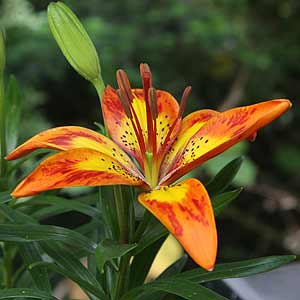Asiatic Hybrids Div1

Asiatic Lilies (or Asiatic Lilium) are an extremely popular bulb to grow in the garden due to the huge range of colors. Not fragrant, in fact no discernible perfume or smell, it is the flowers that these hybrids are all about.
With their trademark outward facing flowers Asiatic Lilies are extremely easy to grow and flower early in the season. As a general full Asiatic Hybrids like a cool root run and a sunny position. ‘Cool feet Warm Head’.
Asiatic Hybrids are amongst the earliest to flower and with a huge color range including spots, freckles and other markings are a most attractive Lilium.
Asiatic Lilies Care
It is a little bit simplistic to say that Liliums prefer full sun, in cooler climates this is true, however as we move southwards to warmer areas they do in fact need a position where they will receive protection from the hot afternoon sun. Not deep shade, but not hot sun either.
The usual humus rich well drained moist soil is the most effective type.
Yes you can grow Asiatics in containers, but they will need some support and the container needs to be kept cool. Although these Liliums do not require a lot of water, they do like some moisture, we like to water with a weak liquid seaweed fertiliser every two week, and we also water each week.
Flowers can be cut for indoors, but remember to leave as much foliage as possible so that the bulbs have plenty of energy. Leave the foliage until it dies right back before removing.
A top dressing of rotted compost and aged manure in late fall will help with overwintering, and provide a good start for next seasons growth.
Propagation
Propagation is by division of established clumps and scaling. Scaling is a process best left to experienced growers.
More information
Asiatic Hybrids (Division1) have been developed from a range of asiatic species including:
Lilium amabile, Lilium bulbiferum, Lilium callosum, Lilium cernuum, Lilium concolor, Lilium dauricum, Lilium davidii, Lilium henryi, Lilium lancifolium, Lilium lankongense, Lilium leichtlinii, Lilium macklinia, Lilium nepalense, Lilium pumilum, Lilium rosthornii, Lilium taliense, Lilium wilsonii and Lilium xanthellum

